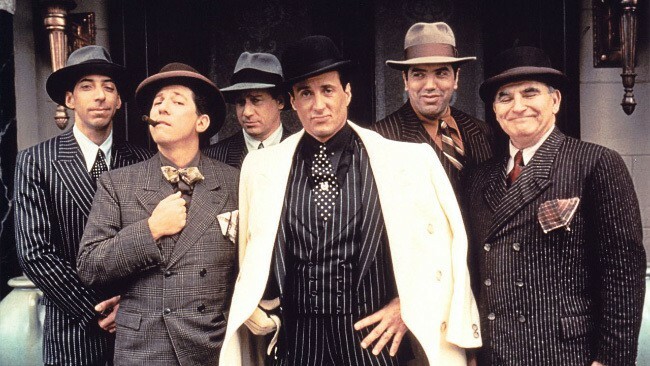CONTENT
- 1 Purpose of instantaneous water heaters
- 2 Device and principle of operation
- 3 Varieties
- 4 Advantages and disadvantages
- 5 How to choose an instantaneous heater for an apartment
- 6 The best heater models
Purpose of instantaneous water heaters
The main purpose of water heaters, regardless of their type, is to heat water to a predetermined temperature. There are two main types of devices: boilers or accumulative, in which cold water is drawn into a tank of a certain size for subsequent heating, and flowing ones, providing the required temperature directly when the tap is opened.
The presence of a water heater will be useful with frequent outages of hot water. The water supply system in the country is built in such a way that every summer there is a planned shutdown hot water supply during preventive maintenance on highways and measures for crimping. In order not to run around the apartment with hot pots, the most correct decision would be to buy a heater.

Device and principle of operation
Structurally, flow-through heaters are usually a cylindrical device. As a rule, these devices are much smaller in size due to the lack of a tank. All flow heaters have a similar design.
Heating element
The part that can be considered the main one, since it is at its expense that the water is heated to the desired temperature. Heating elements are of two types: in the form of an uninsulated spiral or a tubular electric heater (TEN).
In the first case, a pure spiral is used, placed inside a special block made of durable material. Since the internal volume of devices with this type of heater is small enough, there is no heat accumulation, therefore, when turned off, it instantly cools down. But this avoids the appearance of limescale.
The use of heating elements is good from the point of view of electrical safety, since there are no open elements, and the spiral itself is placed in the body of a copper pipe. A distinctive feature of heating elements is a long service life and reliability.
Flow sensor
An element that is needed to turn on the heater when water is supplied. There are electronic sensors and cheaper mechanical counterparts. They consist of a diaphragm bridge that reacts to an increase in fluid pressure by activating a switch.
TOINFORMATION!
The main disadvantage of the mechanical duct fixation system is its low sensitivity. In the absence of sufficient pressure, the heater may simply not turn on.
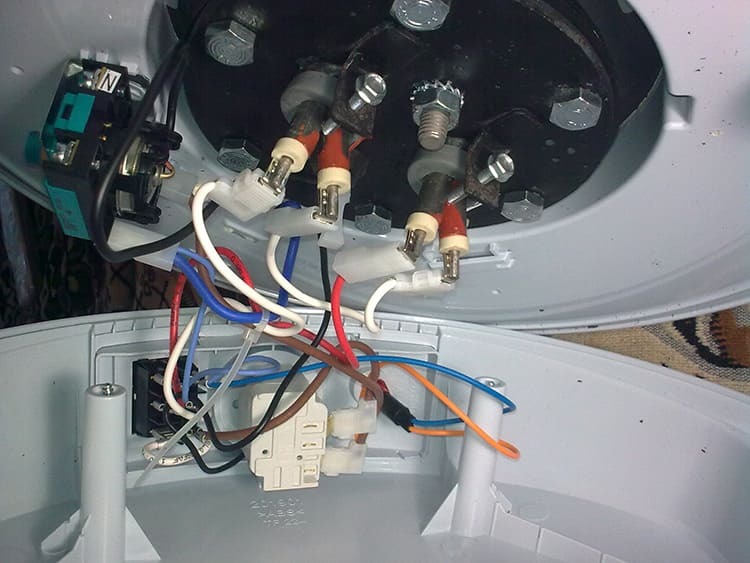
Overheating sensor
A detail that relates to the safety system for the operation of an instantaneous heater. The purpose of the sensor is to turn off the device when the upper temperature threshold is exceeded, which usually varies between 60 ° C and 70 ° C. It is convenient if the device is equipped with a sensor triggering lamp. This will allow the user to understand the reason for the disconnection.
Governing bodies
Their purpose is to set the required temperature and flow rate. More advanced and expensive models have electronic systems that automatically track parameters. The presence of the display will help to clearly know the temperature of the water.
RCD
The residual current device is not located inside the device, but is carried out to the power cord. It is necessary to open the electrical network when a leakage current occurs, in order to avoid injury to a person.
TOINFORMATION!
All devices that are in the bathroom and come into contact with water must be connected via an RCD. Manufacturers of flow heaters equip their devices with a protection system without fail.
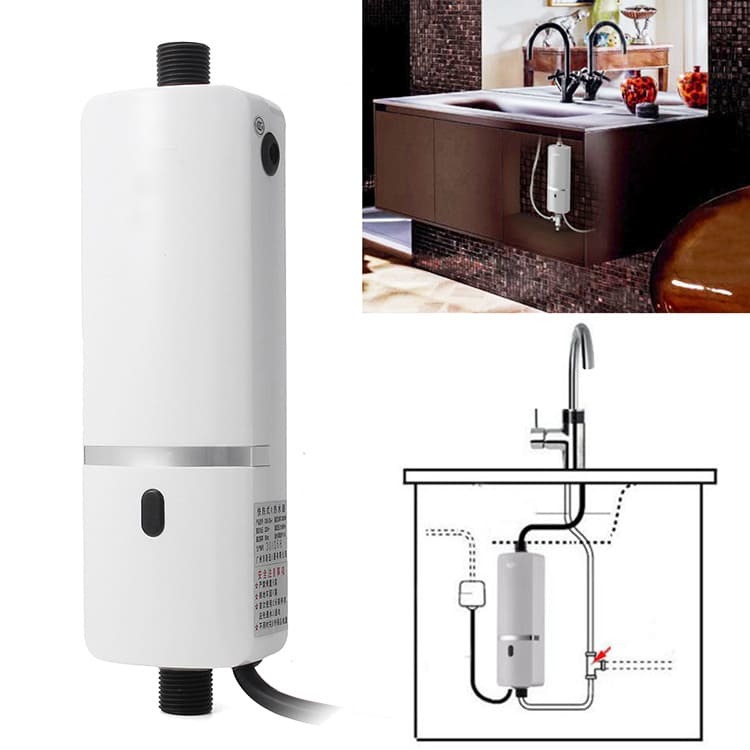
Varieties
All instantaneous water heaters on the market are divided into two types according to the principle of operation. This should be taken into account when the consumer starts deciding which appliance to choose for home use.
Pressure
Powerful devices designed to supply hot water to several sources of water intake. This type is installed in the water supply system, sometimes hidden, and is turned on when the tap is turned.
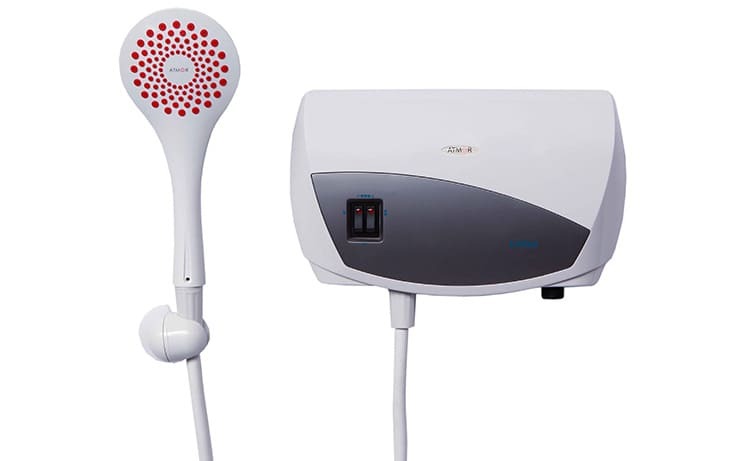
Free-flow
Simple in design devices that are installed directly on the tap and provide water heating for only one source. Some models can be additionally equipped with a special attachment, which allows apply them in the shower.
TOINFORMATION!
Non-pressure instantaneous water heaters will cost significantly less, but it should be borne in mind that they will not be able to provide temperature variability due to their lower power.
Advantages and disadvantages
Any household appliance has its positive and negative sides, which should be considered when making a purchase. This will provide comfort, convenience and get what the device is purchased for.
The advantages of instantaneous water heaters in comparison with storage water heaters can be considered:
- the absence of an internal tank has a positive effect on the overall dimensions, which allows economical use of space;
- ensuring the supply of hot water immediately after opening the tap, which is convenient in a country house;
- the variability of models allows you to choose according to power and type, providing water supply to one or several points.
But flow-through heaters are not without drawbacks. The negative sides are:
- to ensure the supply of hot water to several points at once, sufficient pressure in the system is required;
- increased power consumption, especially in models that provide fast heating due to high power.
How to choose an instantaneous heater for an apartment
When deciding to buy an instantaneous water heater for home use, you should listen to expert advice and decide on the parameters, the consideration of which will allow you to acquire the optimal option.
Power consumption
The most important parameter is the power of the device, since not only its uninterrupted operation, but also the safety of the wiring in the apartment, will depend on it. Finding out the required indicator is quite simple:
- the first step is to determine the amount of water consumed. It is generally accepted that washing hands requires 2 to 4 l / min, for the kitchen the consumption will be 5 l / min, and for taking a shower or bathing up to 10 l / min;
- further, the resulting indicator is substituted into the formula: P = QT / 0.073. Q is the water flow, T is the temperature difference between inlet and outlet.
TOINFORMATION!
An easier way to calculate is to multiply the planned water flow by 2. This will be the desired value.
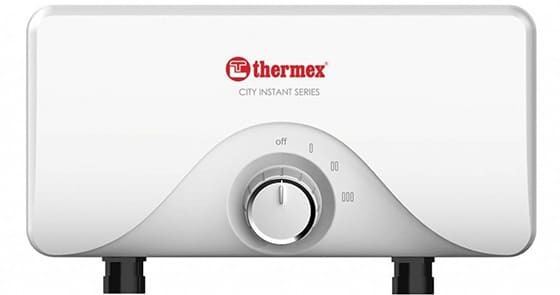
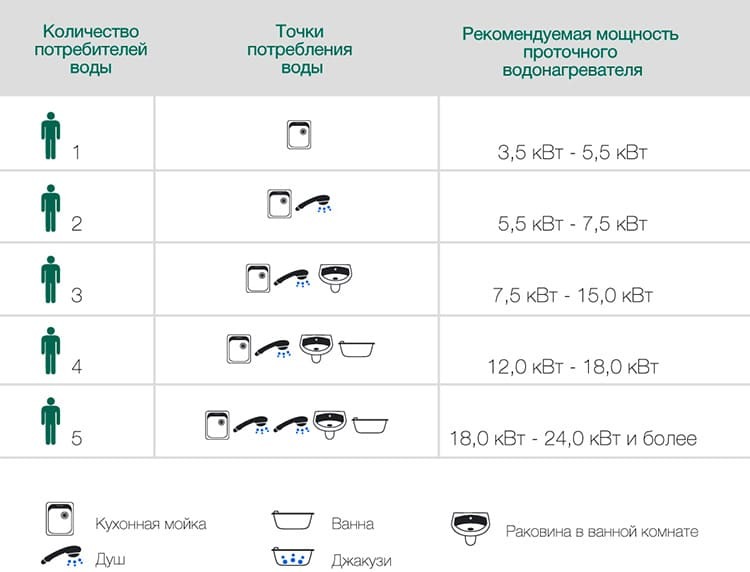
It turns out that to heat the water for the bath, a device from 20 kW is required, and to provide water in the kitchen, a device for 10-16 kW is suitable. It is important to consider here that in old houses the wiring is not designed to connect devices with a power of more than 3.5 kW to the network.
Number of phases
The type of connection is determined depending on the power of the device. This indicator is extremely simple - if a device with a power of up to 12 kW, then it can be powerfully mounted in a standard 220 V network. If the power is higher, then three-phase wiring is required. Most often, these models are installed in country houses.
Heating element type
The rate of water heating and the reliability of the device with frequent use will depend on this parameter. In total, there are three types of heating elements:
- ordinary heating element, which, depending on the model, can be one or more;
- higher price ceramic tubular heaters;
- spiral induction heat exchangers that do not require maintenance and are free of scale during operation.
Manufacturing material
A rather subjective parameter that does not affect the operation of the device, but serves only as a criterion for assessing the appearance. The following options are presented on the market:
- plastic. Easy to clean, fairly cheap material, but over time, scratches appear on the surface, where dirt gets clogged;
- enameled body. A well-applied coating does not lose its appearance for a long time;
- anodized. The new heaters look stylish but wear on the coating over time. Titanium is considered the most durable, but such models are many times more expensive than analogues;
- metal. Uncoated stainless steel or alloy cases are considered the pinnacle of excellence for some users. But it should be borne in mind that over time, the mirror surface will collect stains or fingerprints.
Control type and operating modes
All models of flow heaters available on the market can be divided into two large groups according to the type of control:
- mechanical or hydraulicpresented as a step switch. The main disadvantage is the lack of the ability to set the exact parameters. But these models are considered the most affordable in terms of price;
- electronic, where there are many different modes of operation, and built-in sensors and microprocessors allow monitoring the set parameters, maintaining them. The downside of this type is the high cost.
The purchase of a mechanically controlled water heater is convenient for providing water to one intake point, and the electronics will come in handy for creating a full-fledged water intake network.
Additional options
Budget models are devoid of additional functions, since the manufacturer is trying to reduce the cost of the product as much as possible. All sorts of options are the prerogative of more expensive heaters that can be equipped with:
- several power modes;
- indication of inclusion;
- overheating protection system;
- programmers;
- protection against the appearance of scale;
- limiting the water temperature.
The presence of additional options increases the comfort of using the device, but also greatly increases the price.
Manufacturer
Another subjective selection criterion. There are many heaters on the market, manufactured by both well-known brands and noname firms. TOP 5 leading companies specializing in the production of flow heaters are represented by the following brands:
- Stiebel Eltron. A German brand that produces powerful, multifunctional devices that are easy to install and reliable in operation;
- AEG. Another German manufacturer that produces quality compact devices;
- Electrolux. Swedish brand specializing in the production of mid-range heaters;
- Atmor. An Israeli company that relies on the production of budget models equipped with additional options;
- Timberk. The Swedish company, in the line of which there are several compact and inexpensive flow heaters.
The best heater models
In order to finally decide which instantaneous heater to choose for home use, it will not be superfluous to familiarize yourself with the rating of popular models and reviews of real buyers.
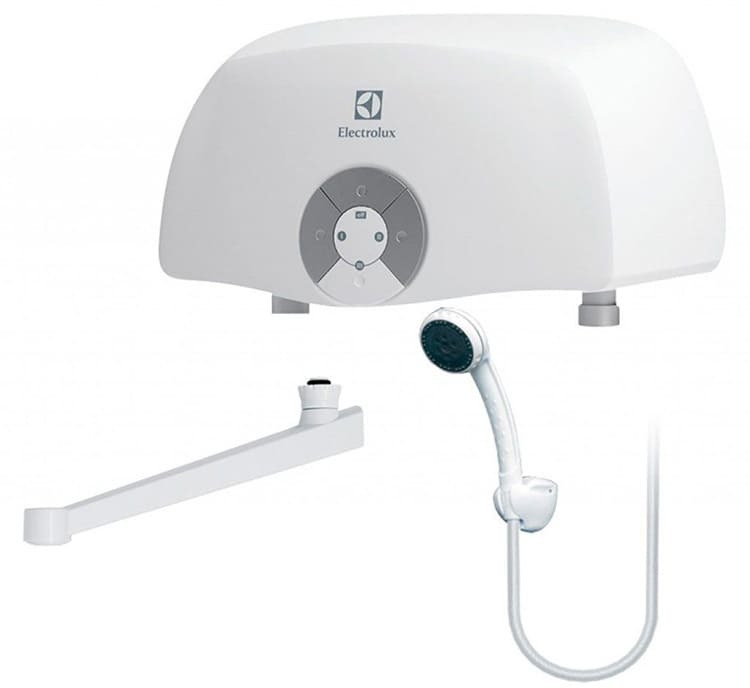
ElectroluxSmartfix 2.0
Inexpensive instantaneous heater with a power of 6.5 kW, equipped with a mechanical control system. Of the features, it is worth highlighting the ease of installation, the presence of three power levels, control of changes in water flow, an overheating protection sensor. This device is designed for one point of water intake, but is additionally equipped with a shower head. Of the minuses, it should be noted that it cannot be used in houses with old wiring. The cost of the model is 2500 rubles.
Heater Electrolux Smartfix 2.0
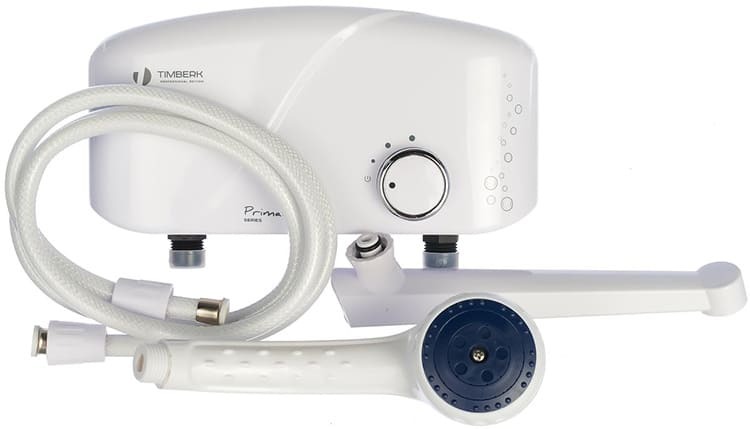
Timberk WHEL-7 OSC
Another inexpensive model that also has 6.5 kW with a maximum output of 4.5 liters per minute. There is a sensor inside the heater that monitors overheating, and there is also a protection system against small impurities. The model provides for a limitation on the minimum temperature of the incoming water - 16 ° C. The main advantage is also the compactness of the device. The cost is 2700 rubles.
Heater Timberk WHEL-7 OSC
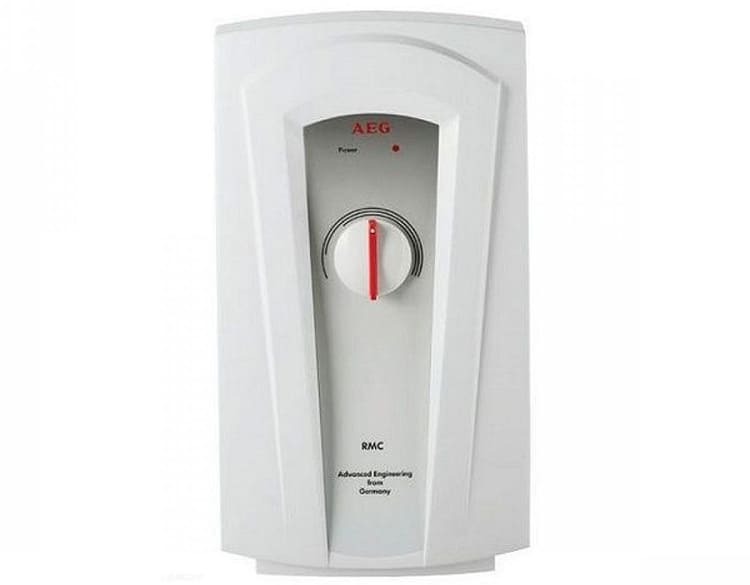
AEG RMC 75
A fairly popular model of the middle price segment (the cost is 13,100 rubles) from a well-known brand. The device is designed to provide several points at once. Power is 7.5 kW, maintains network pressure up to 10 bar. Control type - mechanical. There is overheating protection. A high-strength copper bulb is used as a heating element. The main disadvantage is the overpriced by users.
Heater AEG RMC 75
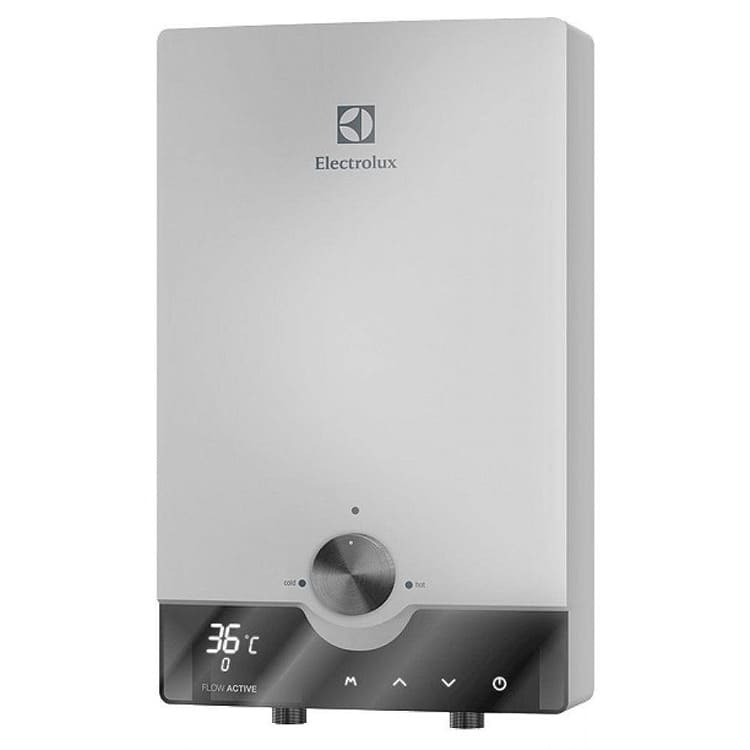
Electrolux NPX 8 Flow Active
A model that belongs to the class of powerful premium devices. The cost of the heater is 245,000 rubles. For this money, the user receives a device that has a temperature setting system in steps of one degree, equipped with an informative display with touch keys, allowing you to program modes work. There is protection against overheating and scale, as well as a self-diagnosis system. The disadvantage is the large size and the plastic flask.
Electrolux NPX 8 Flow Active
Purchasing an instantaneous heater is the only way not to be left without hot water if it is turned off, regardless of the reason for that. There are many parameters to consider when choosing. Once again, you can find out how not to make a mistake with a purchase from the video presented.

